Report on Network Infrastructure Design for APIC Sydney Branch
VerifiedAdded on 2023/01/16
|18
|4009
|95
Report
AI Summary
This report provides a comprehensive analysis of Asia Pacific International College's (APIC) network infrastructure, with a specific focus on the newly established Sydney branch. It begins with an overview of APIC's geographical network scope, presenting a diagram illustrating its global presence. The report then delves into the logical design of the Sydney branch's network, including a three-layer hierarchical diagram, network requirements, IP addressing methods, and subnetting details. Furthermore, it explores virtualization methodologies in cloud computing, recommending two leading cloud service providers, Amazon Web Services (AWS) and Microsoft Azure, and discussing their virtualization techniques and dynamic scaling capabilities. The report concludes with recommendations and a summary of the key findings, providing a detailed assessment of APIC's network infrastructure and its potential for future growth and optimization.

Running head: NETWORK INFRASTRUCTURE FOR APIC
Network Infrastructure for APIC
Name of the Student
Name of the University
Author Note
Network Infrastructure for APIC
Name of the Student
Name of the University
Author Note
Paraphrase This Document
Need a fresh take? Get an instant paraphrase of this document with our AI Paraphraser

1
NETWORK INFRASTRUCTURE FOR APIC
Summary
This report aims to present the geographical scope of the network of Asia Pacific
International College, followed by the logical design of the newly created branch at Sydney
and talks about the virtualization methodologies in cloud computing. After providing a
graphical representation of the global reach of the institute’s network, a brief description is
given after which the report talks about the backbone devices required to implement such a
network as also the segmentation of the network and then lists the uses and current
implementations. Thereafter the logical design for the Sydney branch of APIC is suggested
with the three-layer hierarchical network diagram following which the network requirements
are discussed as well as type of IP and the method of IP addressing before mentioned detailed
subnet calculation in a tabular format. The report then talks about virtualization in cloud
computing where it suggests the two leading cloud service providers and discusses the
techniques of virtualization. Then after talking about dynamic scaling recommendations are
given and the report ends with concluding notes.
NETWORK INFRASTRUCTURE FOR APIC
Summary
This report aims to present the geographical scope of the network of Asia Pacific
International College, followed by the logical design of the newly created branch at Sydney
and talks about the virtualization methodologies in cloud computing. After providing a
graphical representation of the global reach of the institute’s network, a brief description is
given after which the report talks about the backbone devices required to implement such a
network as also the segmentation of the network and then lists the uses and current
implementations. Thereafter the logical design for the Sydney branch of APIC is suggested
with the three-layer hierarchical network diagram following which the network requirements
are discussed as well as type of IP and the method of IP addressing before mentioned detailed
subnet calculation in a tabular format. The report then talks about virtualization in cloud
computing where it suggests the two leading cloud service providers and discusses the
techniques of virtualization. Then after talking about dynamic scaling recommendations are
given and the report ends with concluding notes.
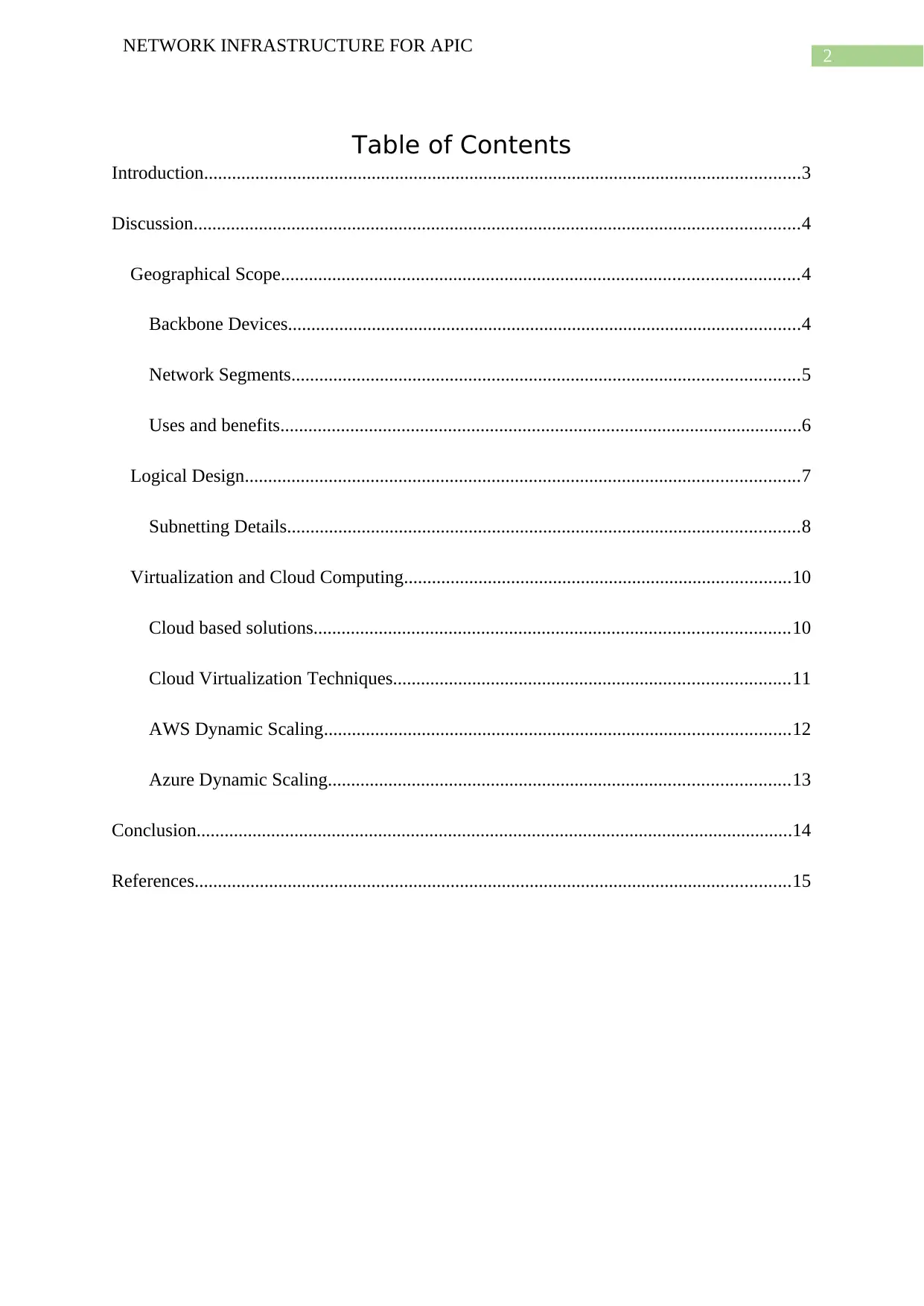
2
NETWORK INFRASTRUCTURE FOR APIC
Table of Contents
Introduction................................................................................................................................3
Discussion..................................................................................................................................4
Geographical Scope...............................................................................................................4
Backbone Devices..............................................................................................................4
Network Segments.............................................................................................................5
Uses and benefits................................................................................................................6
Logical Design.......................................................................................................................7
Subnetting Details..............................................................................................................8
Virtualization and Cloud Computing...................................................................................10
Cloud based solutions......................................................................................................10
Cloud Virtualization Techniques.....................................................................................11
AWS Dynamic Scaling....................................................................................................12
Azure Dynamic Scaling...................................................................................................13
Conclusion................................................................................................................................14
References................................................................................................................................15
NETWORK INFRASTRUCTURE FOR APIC
Table of Contents
Introduction................................................................................................................................3
Discussion..................................................................................................................................4
Geographical Scope...............................................................................................................4
Backbone Devices..............................................................................................................4
Network Segments.............................................................................................................5
Uses and benefits................................................................................................................6
Logical Design.......................................................................................................................7
Subnetting Details..............................................................................................................8
Virtualization and Cloud Computing...................................................................................10
Cloud based solutions......................................................................................................10
Cloud Virtualization Techniques.....................................................................................11
AWS Dynamic Scaling....................................................................................................12
Azure Dynamic Scaling...................................................................................................13
Conclusion................................................................................................................................14
References................................................................................................................................15
⊘ This is a preview!⊘
Do you want full access?
Subscribe today to unlock all pages.

Trusted by 1+ million students worldwide
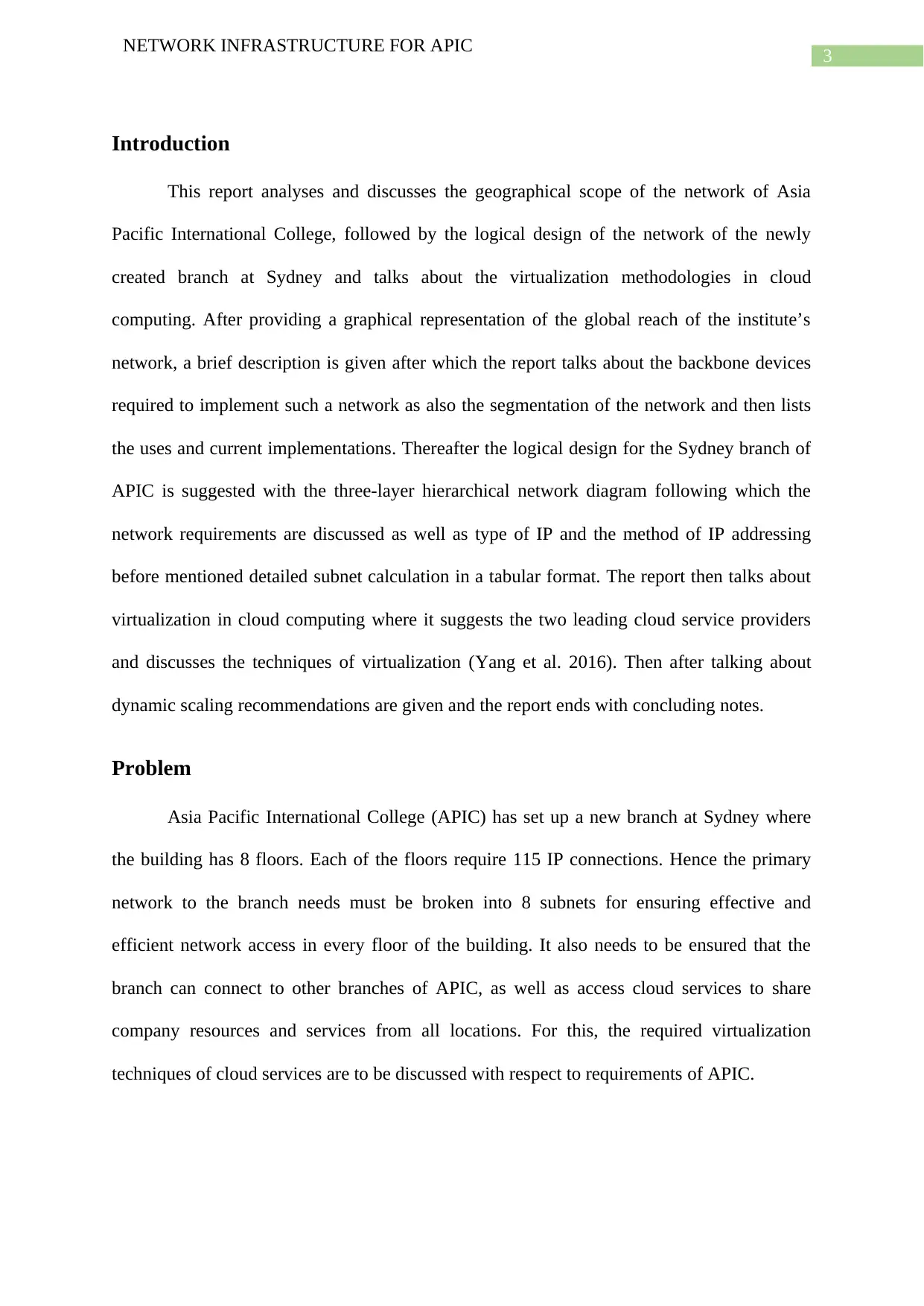
3
NETWORK INFRASTRUCTURE FOR APIC
Introduction
This report analyses and discusses the geographical scope of the network of Asia
Pacific International College, followed by the logical design of the network of the newly
created branch at Sydney and talks about the virtualization methodologies in cloud
computing. After providing a graphical representation of the global reach of the institute’s
network, a brief description is given after which the report talks about the backbone devices
required to implement such a network as also the segmentation of the network and then lists
the uses and current implementations. Thereafter the logical design for the Sydney branch of
APIC is suggested with the three-layer hierarchical network diagram following which the
network requirements are discussed as well as type of IP and the method of IP addressing
before mentioned detailed subnet calculation in a tabular format. The report then talks about
virtualization in cloud computing where it suggests the two leading cloud service providers
and discusses the techniques of virtualization (Yang et al. 2016). Then after talking about
dynamic scaling recommendations are given and the report ends with concluding notes.
Problem
Asia Pacific International College (APIC) has set up a new branch at Sydney where
the building has 8 floors. Each of the floors require 115 IP connections. Hence the primary
network to the branch needs must be broken into 8 subnets for ensuring effective and
efficient network access in every floor of the building. It also needs to be ensured that the
branch can connect to other branches of APIC, as well as access cloud services to share
company resources and services from all locations. For this, the required virtualization
techniques of cloud services are to be discussed with respect to requirements of APIC.
NETWORK INFRASTRUCTURE FOR APIC
Introduction
This report analyses and discusses the geographical scope of the network of Asia
Pacific International College, followed by the logical design of the network of the newly
created branch at Sydney and talks about the virtualization methodologies in cloud
computing. After providing a graphical representation of the global reach of the institute’s
network, a brief description is given after which the report talks about the backbone devices
required to implement such a network as also the segmentation of the network and then lists
the uses and current implementations. Thereafter the logical design for the Sydney branch of
APIC is suggested with the three-layer hierarchical network diagram following which the
network requirements are discussed as well as type of IP and the method of IP addressing
before mentioned detailed subnet calculation in a tabular format. The report then talks about
virtualization in cloud computing where it suggests the two leading cloud service providers
and discusses the techniques of virtualization (Yang et al. 2016). Then after talking about
dynamic scaling recommendations are given and the report ends with concluding notes.
Problem
Asia Pacific International College (APIC) has set up a new branch at Sydney where
the building has 8 floors. Each of the floors require 115 IP connections. Hence the primary
network to the branch needs must be broken into 8 subnets for ensuring effective and
efficient network access in every floor of the building. It also needs to be ensured that the
branch can connect to other branches of APIC, as well as access cloud services to share
company resources and services from all locations. For this, the required virtualization
techniques of cloud services are to be discussed with respect to requirements of APIC.
Paraphrase This Document
Need a fresh take? Get an instant paraphrase of this document with our AI Paraphraser
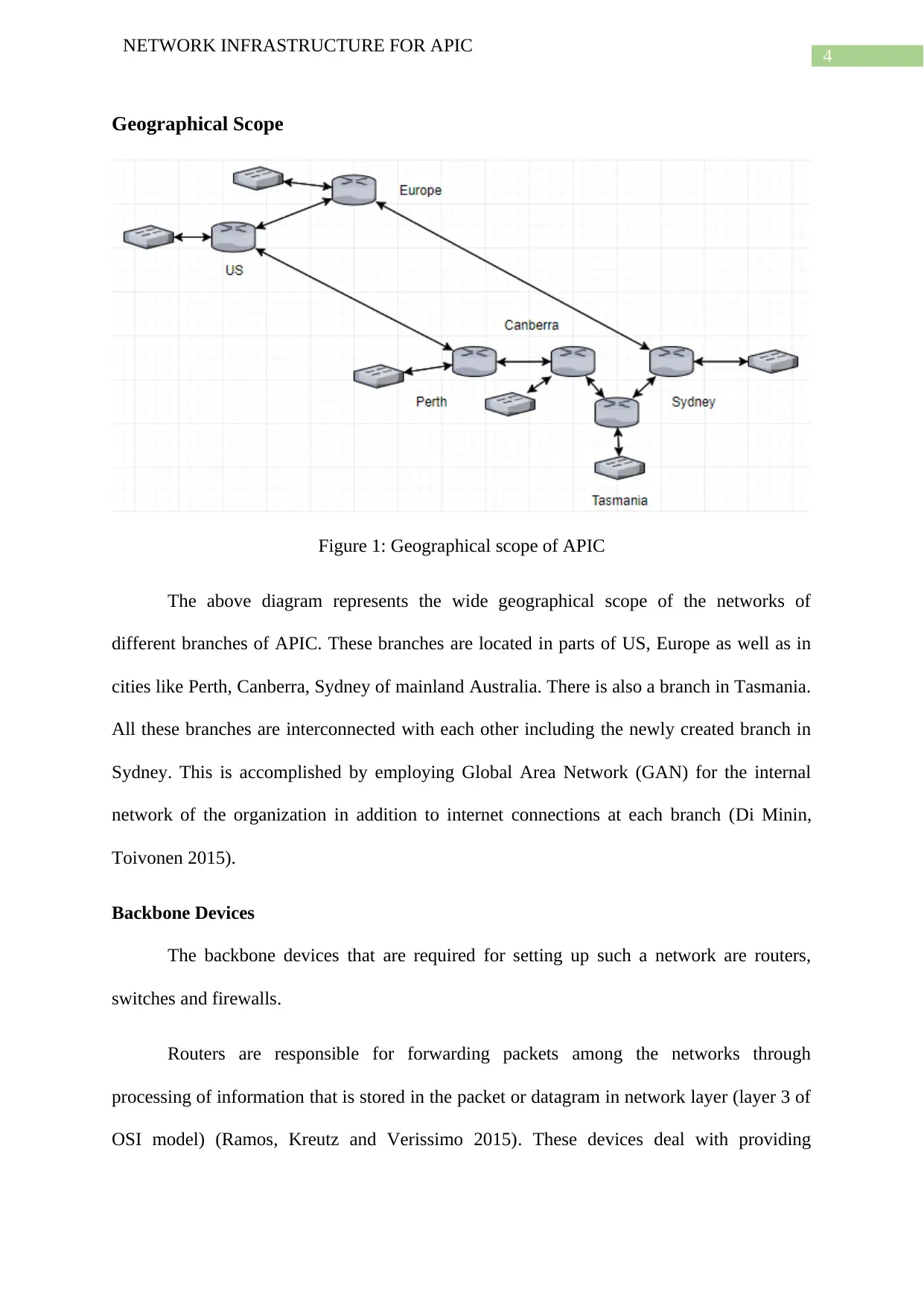
4
NETWORK INFRASTRUCTURE FOR APIC
Geographical Scope
Figure 1: Geographical scope of APIC
The above diagram represents the wide geographical scope of the networks of
different branches of APIC. These branches are located in parts of US, Europe as well as in
cities like Perth, Canberra, Sydney of mainland Australia. There is also a branch in Tasmania.
All these branches are interconnected with each other including the newly created branch in
Sydney. This is accomplished by employing Global Area Network (GAN) for the internal
network of the organization in addition to internet connections at each branch (Di Minin,
Toivonen 2015).
Backbone Devices
The backbone devices that are required for setting up such a network are routers,
switches and firewalls.
Routers are responsible for forwarding packets among the networks through
processing of information that is stored in the packet or datagram in network layer (layer 3 of
OSI model) (Ramos, Kreutz and Verissimo 2015). These devices deal with providing
NETWORK INFRASTRUCTURE FOR APIC
Geographical Scope
Figure 1: Geographical scope of APIC
The above diagram represents the wide geographical scope of the networks of
different branches of APIC. These branches are located in parts of US, Europe as well as in
cities like Perth, Canberra, Sydney of mainland Australia. There is also a branch in Tasmania.
All these branches are interconnected with each other including the newly created branch in
Sydney. This is accomplished by employing Global Area Network (GAN) for the internal
network of the organization in addition to internet connections at each branch (Di Minin,
Toivonen 2015).
Backbone Devices
The backbone devices that are required for setting up such a network are routers,
switches and firewalls.
Routers are responsible for forwarding packets among the networks through
processing of information that is stored in the packet or datagram in network layer (layer 3 of
OSI model) (Ramos, Kreutz and Verissimo 2015). These devices deal with providing

5
NETWORK INFRASTRUCTURE FOR APIC
network access to clients and servers of each branch as also interconnecting with routers of
other branches to form a part of the internal network of the organization.
Switches are required for distributing the network access obtained from the router.
These devices filter and forward datagrams among the ports with respect to the MAC
addresses specified in packets of information. Switches typically come with several ports
enabling devices to be connected in a star topology.
Firewalls not just play an active role in providing security against malicious
applications but also protects network components from being hijacked and prevents other
exploits by providing proactive threat protection against zero-day attacks (Jeong et al 2015).
Firewalls can come in the form of standalone devices as well as software solutions.
Network Segments
The network in each branch is segmented into multiple subnets for efficiently providing
the network access. Advantages of subnetting the major network can be:
Improved performance through reduced congestion
If one subnet is compromised, the impact stays limited to that subnet
Network problems can be contained to specific parts of the network
VLANs can be used to control access of visitors in the network
Security of the network can also be improved by subnetting as it enables zoning of the
cyber security threats to limit the movement through the network. Such segregation or
segmentation is generally achieved by combining VLANs, firewalls and SDNs (Software
defined Networking.
Uses and benefits
The Global Area Network or GAN offers extensive geographical areas to be covered
by the network, helps centralize data of organizations having multiple branches, ensures
NETWORK INFRASTRUCTURE FOR APIC
network access to clients and servers of each branch as also interconnecting with routers of
other branches to form a part of the internal network of the organization.
Switches are required for distributing the network access obtained from the router.
These devices filter and forward datagrams among the ports with respect to the MAC
addresses specified in packets of information. Switches typically come with several ports
enabling devices to be connected in a star topology.
Firewalls not just play an active role in providing security against malicious
applications but also protects network components from being hijacked and prevents other
exploits by providing proactive threat protection against zero-day attacks (Jeong et al 2015).
Firewalls can come in the form of standalone devices as well as software solutions.
Network Segments
The network in each branch is segmented into multiple subnets for efficiently providing
the network access. Advantages of subnetting the major network can be:
Improved performance through reduced congestion
If one subnet is compromised, the impact stays limited to that subnet
Network problems can be contained to specific parts of the network
VLANs can be used to control access of visitors in the network
Security of the network can also be improved by subnetting as it enables zoning of the
cyber security threats to limit the movement through the network. Such segregation or
segmentation is generally achieved by combining VLANs, firewalls and SDNs (Software
defined Networking.
Uses and benefits
The Global Area Network or GAN offers extensive geographical areas to be covered
by the network, helps centralize data of organizations having multiple branches, ensures
⊘ This is a preview!⊘
Do you want full access?
Subscribe today to unlock all pages.

Trusted by 1+ million students worldwide
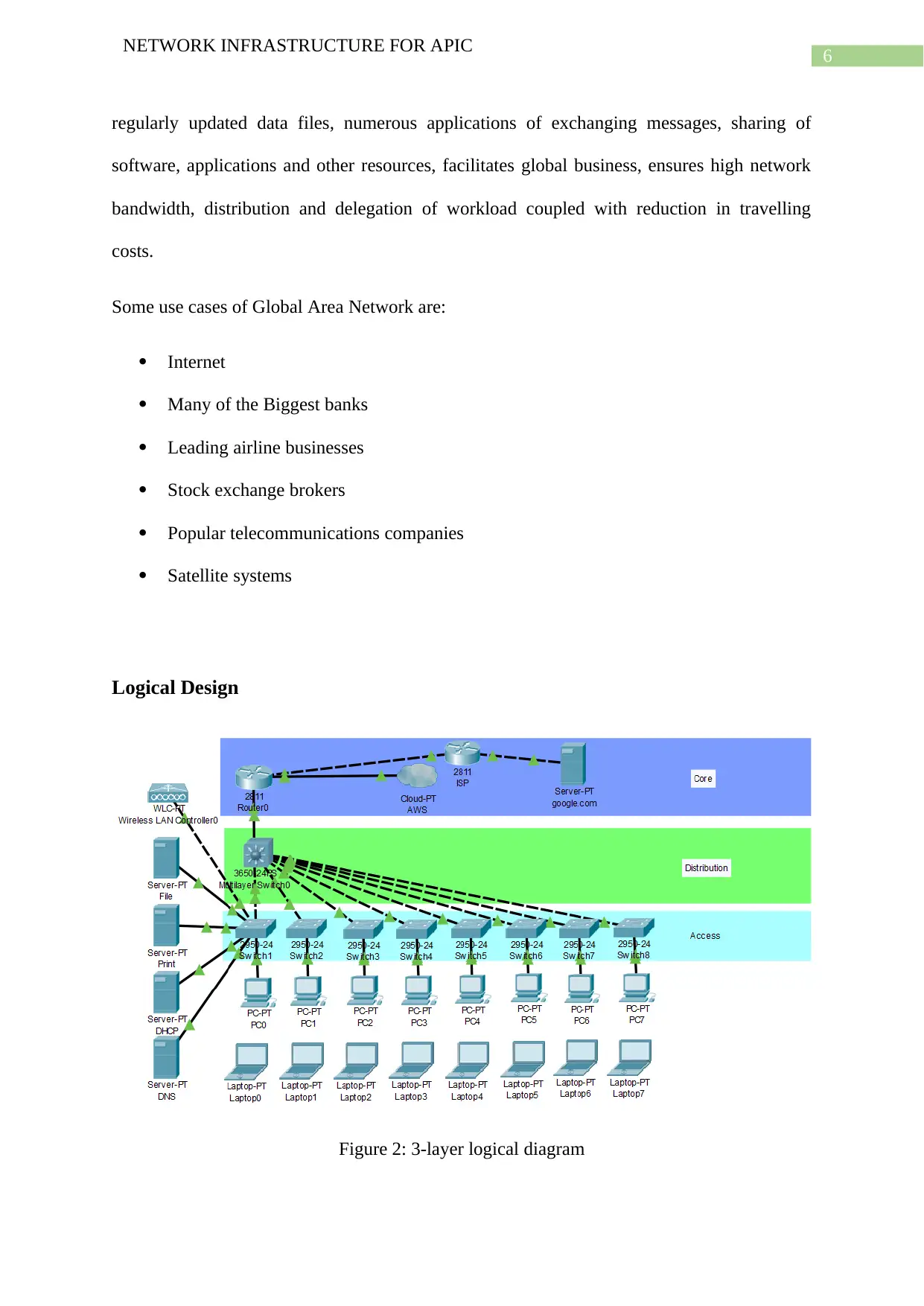
6
NETWORK INFRASTRUCTURE FOR APIC
regularly updated data files, numerous applications of exchanging messages, sharing of
software, applications and other resources, facilitates global business, ensures high network
bandwidth, distribution and delegation of workload coupled with reduction in travelling
costs.
Some use cases of Global Area Network are:
Internet
Many of the Biggest banks
Leading airline businesses
Stock exchange brokers
Popular telecommunications companies
Satellite systems
Logical Design
Figure 2: 3-layer logical diagram
NETWORK INFRASTRUCTURE FOR APIC
regularly updated data files, numerous applications of exchanging messages, sharing of
software, applications and other resources, facilitates global business, ensures high network
bandwidth, distribution and delegation of workload coupled with reduction in travelling
costs.
Some use cases of Global Area Network are:
Internet
Many of the Biggest banks
Leading airline businesses
Stock exchange brokers
Popular telecommunications companies
Satellite systems
Logical Design
Figure 2: 3-layer logical diagram
Paraphrase This Document
Need a fresh take? Get an instant paraphrase of this document with our AI Paraphraser
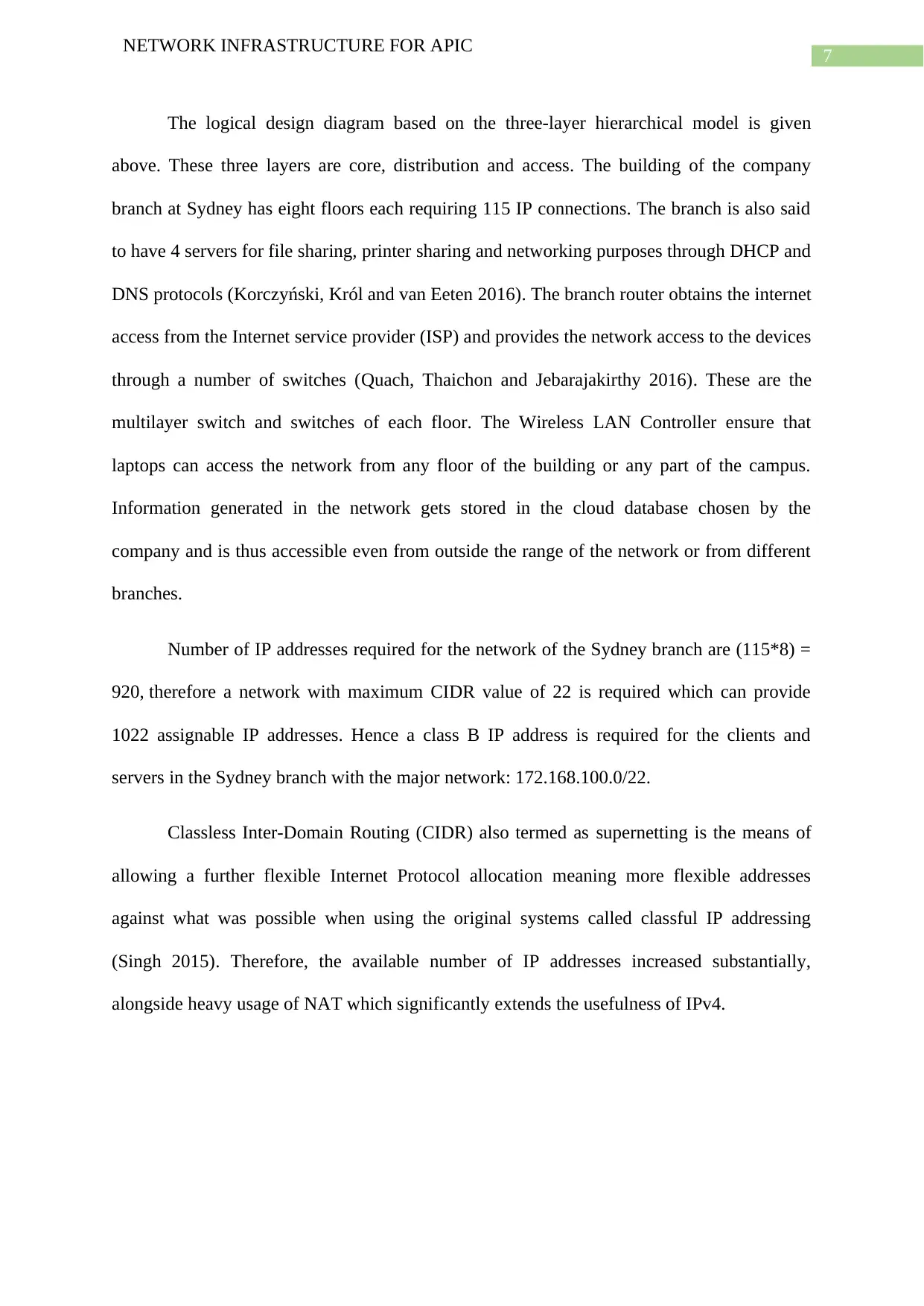
7
NETWORK INFRASTRUCTURE FOR APIC
The logical design diagram based on the three-layer hierarchical model is given
above. These three layers are core, distribution and access. The building of the company
branch at Sydney has eight floors each requiring 115 IP connections. The branch is also said
to have 4 servers for file sharing, printer sharing and networking purposes through DHCP and
DNS protocols (Korczyński, Król and van Eeten 2016). The branch router obtains the internet
access from the Internet service provider (ISP) and provides the network access to the devices
through a number of switches (Quach, Thaichon and Jebarajakirthy 2016). These are the
multilayer switch and switches of each floor. The Wireless LAN Controller ensure that
laptops can access the network from any floor of the building or any part of the campus.
Information generated in the network gets stored in the cloud database chosen by the
company and is thus accessible even from outside the range of the network or from different
branches.
Number of IP addresses required for the network of the Sydney branch are (115*8) =
920, therefore a network with maximum CIDR value of 22 is required which can provide
1022 assignable IP addresses. Hence a class B IP address is required for the clients and
servers in the Sydney branch with the major network: 172.168.100.0/22.
Classless Inter-Domain Routing (CIDR) also termed as supernetting is the means of
allowing a further flexible Internet Protocol allocation meaning more flexible addresses
against what was possible when using the original systems called classful IP addressing
(Singh 2015). Therefore, the available number of IP addresses increased substantially,
alongside heavy usage of NAT which significantly extends the usefulness of IPv4.
NETWORK INFRASTRUCTURE FOR APIC
The logical design diagram based on the three-layer hierarchical model is given
above. These three layers are core, distribution and access. The building of the company
branch at Sydney has eight floors each requiring 115 IP connections. The branch is also said
to have 4 servers for file sharing, printer sharing and networking purposes through DHCP and
DNS protocols (Korczyński, Król and van Eeten 2016). The branch router obtains the internet
access from the Internet service provider (ISP) and provides the network access to the devices
through a number of switches (Quach, Thaichon and Jebarajakirthy 2016). These are the
multilayer switch and switches of each floor. The Wireless LAN Controller ensure that
laptops can access the network from any floor of the building or any part of the campus.
Information generated in the network gets stored in the cloud database chosen by the
company and is thus accessible even from outside the range of the network or from different
branches.
Number of IP addresses required for the network of the Sydney branch are (115*8) =
920, therefore a network with maximum CIDR value of 22 is required which can provide
1022 assignable IP addresses. Hence a class B IP address is required for the clients and
servers in the Sydney branch with the major network: 172.168.100.0/22.
Classless Inter-Domain Routing (CIDR) also termed as supernetting is the means of
allowing a further flexible Internet Protocol allocation meaning more flexible addresses
against what was possible when using the original systems called classful IP addressing
(Singh 2015). Therefore, the available number of IP addresses increased substantially,
alongside heavy usage of NAT which significantly extends the usefulness of IPv4.
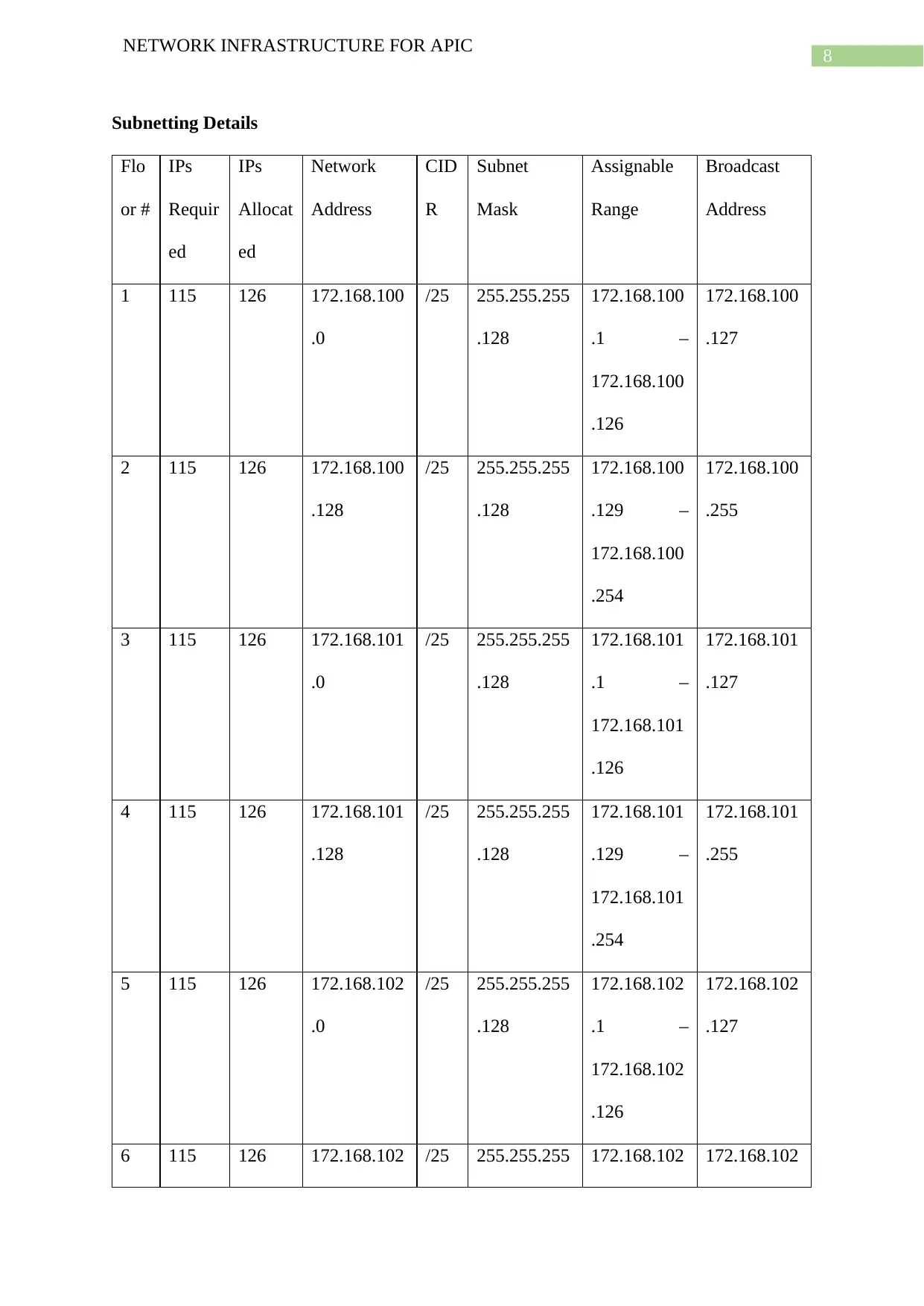
8
NETWORK INFRASTRUCTURE FOR APIC
Subnetting Details
Flo
or #
IPs
Requir
ed
IPs
Allocat
ed
Network
Address
CID
R
Subnet
Mask
Assignable
Range
Broadcast
Address
1 115 126 172.168.100
.0
/25 255.255.255
.128
172.168.100
.1 –
172.168.100
.126
172.168.100
.127
2 115 126 172.168.100
.128
/25 255.255.255
.128
172.168.100
.129 –
172.168.100
.254
172.168.100
.255
3 115 126 172.168.101
.0
/25 255.255.255
.128
172.168.101
.1 –
172.168.101
.126
172.168.101
.127
4 115 126 172.168.101
.128
/25 255.255.255
.128
172.168.101
.129 –
172.168.101
.254
172.168.101
.255
5 115 126 172.168.102
.0
/25 255.255.255
.128
172.168.102
.1 –
172.168.102
.126
172.168.102
.127
6 115 126 172.168.102 /25 255.255.255 172.168.102 172.168.102
NETWORK INFRASTRUCTURE FOR APIC
Subnetting Details
Flo
or #
IPs
Requir
ed
IPs
Allocat
ed
Network
Address
CID
R
Subnet
Mask
Assignable
Range
Broadcast
Address
1 115 126 172.168.100
.0
/25 255.255.255
.128
172.168.100
.1 –
172.168.100
.126
172.168.100
.127
2 115 126 172.168.100
.128
/25 255.255.255
.128
172.168.100
.129 –
172.168.100
.254
172.168.100
.255
3 115 126 172.168.101
.0
/25 255.255.255
.128
172.168.101
.1 –
172.168.101
.126
172.168.101
.127
4 115 126 172.168.101
.128
/25 255.255.255
.128
172.168.101
.129 –
172.168.101
.254
172.168.101
.255
5 115 126 172.168.102
.0
/25 255.255.255
.128
172.168.102
.1 –
172.168.102
.126
172.168.102
.127
6 115 126 172.168.102 /25 255.255.255 172.168.102 172.168.102
⊘ This is a preview!⊘
Do you want full access?
Subscribe today to unlock all pages.

Trusted by 1+ million students worldwide

9
NETWORK INFRASTRUCTURE FOR APIC
.128 .128 .129 –
172.168.102
.254
.255
7 115 126 172.168.103
.0
/25 255.255.255
.128
172.168.103
.1 –
172.168.103
.126
172.168.103
.127
8 115 126 172.168.103
.128
/25 255.255.255
.128
172.168.103
.129 –
172.168.103
.254
172.168.103
.255
Virtualization and Cloud Computing
Cloud based solutions
Two organizations that provide computing and storage services based on cloud which
can be appropriate for Asia Pacific International College in hosting web and email servers are
Amazon and Microsoft with their proven AWS and Azure based products respectively.
Azure and AWS are solid cloud solutions which perform pretty much similarly in
roughly all of the use cases. The organizational requirements or business decisions are the
only criteria based on which companies end up choosing one against the other. When it
comes to flexible compute, storage, networking and pricing the basic abilities of these
solutions are almost same. The elements between Azure and AWS relating to public clouds
can be - autoscaling, self-service, instant provisioning security, compliance, identity access
management and pay-as-u-go pricing (Annette, Banu and Chandran 2015).
NETWORK INFRASTRUCTURE FOR APIC
.128 .128 .129 –
172.168.102
.254
.255
7 115 126 172.168.103
.0
/25 255.255.255
.128
172.168.103
.1 –
172.168.103
.126
172.168.103
.127
8 115 126 172.168.103
.128
/25 255.255.255
.128
172.168.103
.129 –
172.168.103
.254
172.168.103
.255
Virtualization and Cloud Computing
Cloud based solutions
Two organizations that provide computing and storage services based on cloud which
can be appropriate for Asia Pacific International College in hosting web and email servers are
Amazon and Microsoft with their proven AWS and Azure based products respectively.
Azure and AWS are solid cloud solutions which perform pretty much similarly in
roughly all of the use cases. The organizational requirements or business decisions are the
only criteria based on which companies end up choosing one against the other. When it
comes to flexible compute, storage, networking and pricing the basic abilities of these
solutions are almost same. The elements between Azure and AWS relating to public clouds
can be - autoscaling, self-service, instant provisioning security, compliance, identity access
management and pay-as-u-go pricing (Annette, Banu and Chandran 2015).
Paraphrase This Document
Need a fresh take? Get an instant paraphrase of this document with our AI Paraphraser
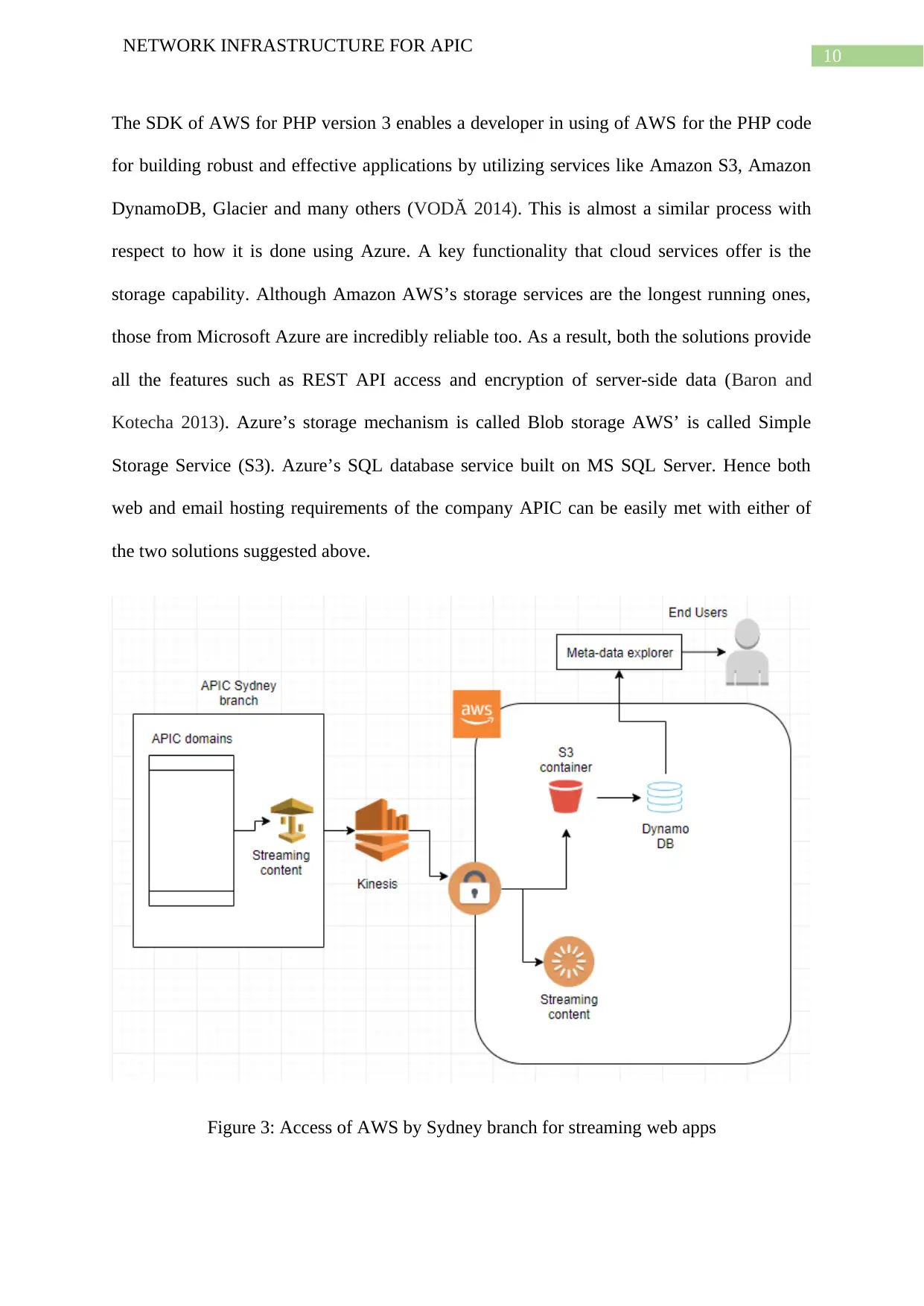
10
NETWORK INFRASTRUCTURE FOR APIC
The SDK of AWS for PHP version 3 enables a developer in using of AWS for the PHP code
for building robust and effective applications by utilizing services like Amazon S3, Amazon
DynamoDB, Glacier and many others (VODĂ 2014). This is almost a similar process with
respect to how it is done using Azure. A key functionality that cloud services offer is the
storage capability. Although Amazon AWS’s storage services are the longest running ones,
those from Microsoft Azure are incredibly reliable too. As a result, both the solutions provide
all the features such as REST API access and encryption of server-side data (Baron and
Kotecha 2013). Azure’s storage mechanism is called Blob storage AWS’ is called Simple
Storage Service (S3). Azure’s SQL database service built on MS SQL Server. Hence both
web and email hosting requirements of the company APIC can be easily met with either of
the two solutions suggested above.
Figure 3: Access of AWS by Sydney branch for streaming web apps
NETWORK INFRASTRUCTURE FOR APIC
The SDK of AWS for PHP version 3 enables a developer in using of AWS for the PHP code
for building robust and effective applications by utilizing services like Amazon S3, Amazon
DynamoDB, Glacier and many others (VODĂ 2014). This is almost a similar process with
respect to how it is done using Azure. A key functionality that cloud services offer is the
storage capability. Although Amazon AWS’s storage services are the longest running ones,
those from Microsoft Azure are incredibly reliable too. As a result, both the solutions provide
all the features such as REST API access and encryption of server-side data (Baron and
Kotecha 2013). Azure’s storage mechanism is called Blob storage AWS’ is called Simple
Storage Service (S3). Azure’s SQL database service built on MS SQL Server. Hence both
web and email hosting requirements of the company APIC can be easily met with either of
the two solutions suggested above.
Figure 3: Access of AWS by Sydney branch for streaming web apps
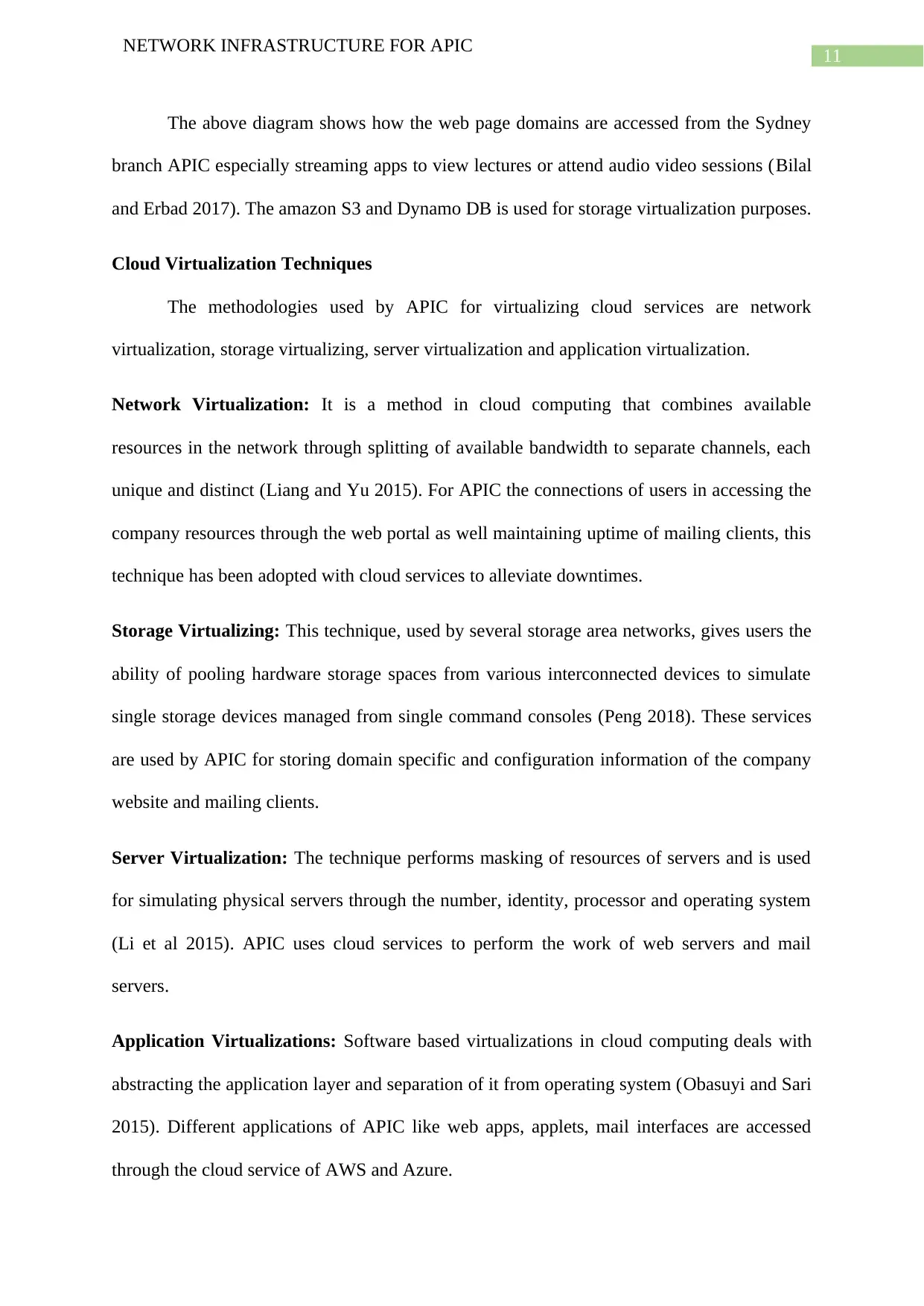
11
NETWORK INFRASTRUCTURE FOR APIC
The above diagram shows how the web page domains are accessed from the Sydney
branch APIC especially streaming apps to view lectures or attend audio video sessions (Bilal
and Erbad 2017). The amazon S3 and Dynamo DB is used for storage virtualization purposes.
Cloud Virtualization Techniques
The methodologies used by APIC for virtualizing cloud services are network
virtualization, storage virtualizing, server virtualization and application virtualization.
Network Virtualization: It is a method in cloud computing that combines available
resources in the network through splitting of available bandwidth to separate channels, each
unique and distinct (Liang and Yu 2015). For APIC the connections of users in accessing the
company resources through the web portal as well maintaining uptime of mailing clients, this
technique has been adopted with cloud services to alleviate downtimes.
Storage Virtualizing: This technique, used by several storage area networks, gives users the
ability of pooling hardware storage spaces from various interconnected devices to simulate
single storage devices managed from single command consoles (Peng 2018). These services
are used by APIC for storing domain specific and configuration information of the company
website and mailing clients.
Server Virtualization: The technique performs masking of resources of servers and is used
for simulating physical servers through the number, identity, processor and operating system
(Li et al 2015). APIC uses cloud services to perform the work of web servers and mail
servers.
Application Virtualizations: Software based virtualizations in cloud computing deals with
abstracting the application layer and separation of it from operating system (Obasuyi and Sari
2015). Different applications of APIC like web apps, applets, mail interfaces are accessed
through the cloud service of AWS and Azure.
NETWORK INFRASTRUCTURE FOR APIC
The above diagram shows how the web page domains are accessed from the Sydney
branch APIC especially streaming apps to view lectures or attend audio video sessions (Bilal
and Erbad 2017). The amazon S3 and Dynamo DB is used for storage virtualization purposes.
Cloud Virtualization Techniques
The methodologies used by APIC for virtualizing cloud services are network
virtualization, storage virtualizing, server virtualization and application virtualization.
Network Virtualization: It is a method in cloud computing that combines available
resources in the network through splitting of available bandwidth to separate channels, each
unique and distinct (Liang and Yu 2015). For APIC the connections of users in accessing the
company resources through the web portal as well maintaining uptime of mailing clients, this
technique has been adopted with cloud services to alleviate downtimes.
Storage Virtualizing: This technique, used by several storage area networks, gives users the
ability of pooling hardware storage spaces from various interconnected devices to simulate
single storage devices managed from single command consoles (Peng 2018). These services
are used by APIC for storing domain specific and configuration information of the company
website and mailing clients.
Server Virtualization: The technique performs masking of resources of servers and is used
for simulating physical servers through the number, identity, processor and operating system
(Li et al 2015). APIC uses cloud services to perform the work of web servers and mail
servers.
Application Virtualizations: Software based virtualizations in cloud computing deals with
abstracting the application layer and separation of it from operating system (Obasuyi and Sari
2015). Different applications of APIC like web apps, applets, mail interfaces are accessed
through the cloud service of AWS and Azure.
⊘ This is a preview!⊘
Do you want full access?
Subscribe today to unlock all pages.

Trusted by 1+ million students worldwide
1 out of 18
Related Documents
Your All-in-One AI-Powered Toolkit for Academic Success.
+13062052269
info@desklib.com
Available 24*7 on WhatsApp / Email
![[object Object]](/_next/static/media/star-bottom.7253800d.svg)
Unlock your academic potential
Copyright © 2020–2025 A2Z Services. All Rights Reserved. Developed and managed by ZUCOL.





